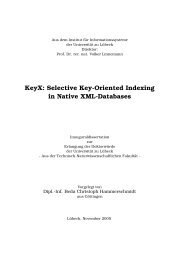Augenbewegungsstörungen bei Spinozerebellärer Ataxie Typ 17 ...
Augenbewegungsstörungen bei Spinozerebellärer Ataxie Typ 17 ...
Augenbewegungsstörungen bei Spinozerebellärer Ataxie Typ 17 ...
Sie wollen auch ein ePaper? Erhöhen Sie die Reichweite Ihrer Titel.
YUMPU macht aus Druck-PDFs automatisch weboptimierte ePaper, die Google liebt.
Literaturverzeichnis<br />
1. Bahill AT, Stark L. Overlapping saccades and glissades are produced by fatigue in the<br />
saccadic eye movement system. Exp Neurol 1975; 48(1):95-106.<br />
2. Barton JJ, Sharpe JA, Raymond JE. Directional defects in pursuit and motion perception<br />
in humans with unilateral cerebral lesions. Brain 1996; 119 (Pt 5):1535-<br />
1550.<br />
3. Bird, T. D. Hereditary Ataxia Overview. http://www.geneclinics.org/servlet/access?db=<br />
geneclinics&site=gt&id=8888891&key=uCsjelzuu8avk&gry=&fcn=y&fw=<br />
SEuY&filename=/profiles/ataxias/index.html<br />
(Tag des letzten Zugriffs: 27.09.2007).<br />
4. Biscaldi M, Fischer B, Stuhr V. Human express saccade makers are impaired at<br />
suppressing visually evoked saccades. J Neurophysiol 1996; 76(1):199-214.<br />
5. Bruni AC, Takahashi-Fujigasaki J, Maltecca F, Foncin JF, Servadio A, Casari G,<br />
D'Adamo P, Maletta R, Curcio SA, De Michele G, Filla A, El Hachimi KH,<br />
Duyckaerts C. Behavioral disorder, dementia, ataxia, and rigidity in a large<br />
family with TATA box-binding protein mutation. Arch Neurol 2004;<br />
61(8):1314-1320.<br />
6. Burk K, Abele M, Fetter M, Dichgans J, Skalej M, Laccone F, Didierjean O, Brice A,<br />
Klockgether T. Autosomal dominant cerebellar ataxia type I clinical<br />
features and MRI in families with SCA1, SCA2 and SCA3. Brain 1996; 119<br />
(Pt 5):1497-1505.<br />
7. Burk K, Fetter M, Abele M, Laccone F, Brice A, Dichgans J, Klockgether T. Autosomal<br />
dominant cerebellar ataxia type I: oculomotor abnormalities in families with<br />
SCA1, SCA2, and SCA3. J Neurol 1999; 246(9):789-797.<br />
8. Buttner N, Geschwind D, Jen JC, Perlman S, Pulst SM, Baloh RW. Oculomotor<br />
phenotypes in autosomal dominant ataxias. Arch Neurol 1998; 55(10):1353-<br />
1357.<br />
9. Day JW, Schut LJ, Moseley ML, Durand AC, Ranum LP. Spinocerebellar ataxia type 8:<br />
clinical features in a large family. Neurology 2000; 55(5):649-657.<br />
10. Dursteler MR, Wurtz RH. Pursuit and optokinetic deficits following chemical lesions<br />
of cortical areas MT and MST. J Neurophysiol 1988; 60(3):940-965.<br />
11. Glasauer S, Hoshi M, Kempermann U, Eggert T, Buttner U. Three-dimensional eye<br />
position and slow phase velocity in humans with downbeat nystagmus. J<br />
Neurophysiol 2003; 89(1):338-354.<br />
12. Gomez CM, Thompson RM, Gammack JT, Perlman SL, Dobyns WB, Truwit CL, Zee<br />
DS, Clark HB, Anderson JH. Spinocerebellar ataxia type 6: gaze-evoked<br />
and vertical nystagmus, Purkinje cell degeneration, and variable age of<br />
onset. Ann Neurol 1997; 42(6):933-950.

















